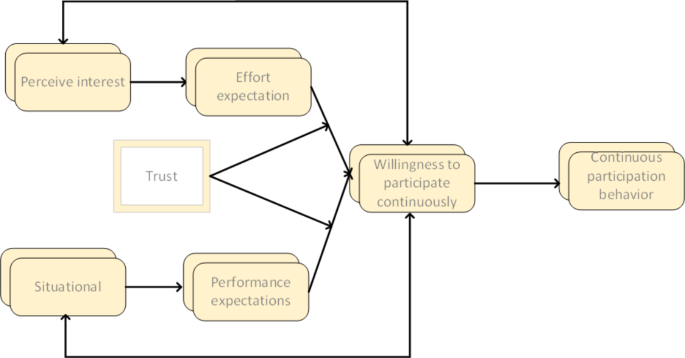Understanding the Integrated Technology Acceptance and Usage Framework
The integrated model of technology acceptance and usage, known as the Unified Theory of Acceptance and Use of Technology (UTAUT), is fundamentally rooted in the Technology Acceptance Model (TAM). This comprehensive framework incorporates elements from seven different theories: technology acceptance, theory of planned behavior, social cognitive theory, innovation diffusion theory, incentive models, and theories concerning computer usage. The model identifies four critical factors that influence users’ intentions to use technology: performance expectations, effort expectations, social influence, and facilitating conditions. Additionally, it highlights control variables such as gender, age, prior experience, and voluntary engagement that notably shape these primary factors.
Key Components of the UTAUT Model
Performance expectation refers to user perceptions regarding a system’s usefulness. This encompasses five foundational variables: perceived usefulness itself; external motivations for using the technology; task consistency; comparative advantages over alternatives; and expected outcomes from its use. Meanwhile, effort expectation refers to the perception regarding how much exertion is required when utilizing a system—this comprises three components: perceived ease of use; complexity levels associated with usage; and general usability. Social influence captures how much individuals feel impacted by their environment in terms of opinion from peers or authority figures around them—this includes subjective norms alongside broader social factors that contribute to one’s public image.
Facilitating conditions focus on individuals’ perceptions about their control over relevant technologies or resources available for use which can be considered unessential when evaluating an individual’s likelihood to engage with new systems.

The Importance of Sustainable Development in Youth Skating Training
This research aims at advancing sustainable practices within skating training programs for teenagers while fostering environmental stewardship. Findings indicate that engaging young people in skating not only enhances physical competency but also enriches theoretical understanding across various sporting principles—a facet crucial for educational growth.
Moreover, participants’ enjoyment levels during training significantly correlate with how attentive they are throughout sessions—as this directly influences their confidence levels regarding ongoing involvement in activities offered by clubs or institutions. Trust plays an instrumental role too—the confidence trainees have in their coaches along with training organizations impacts both intellectual assimilation related to skills taught during sessions as well as overall effectiveness leading toward future engagement decisions initiated by them.
The Mediating Role of Contextual Factors
The conceptual framework illustrated posits that adolescents’ interest in skating positively affects their anticipated exertion levels when participating alongside desires for continued involvement within these initiatives. Notably influenced too are actual experiences encountered during training sessions which shape future expectations surrounding participation opportunities available within contexts structured like this one providing additional layers affecting decision-making processes eventually regulating engagement outcomes amid youths involved.
Figure 7:
A visual representation illustrating continuous participation behaviors exhibited by young skaters aligns closely with previous discussions highlighting underlying motivators driving sustained interest.
A Structural Formula Approach to Sustainable Skating Training Models
This section covers structural formula modelling extracted from insights gained about sustainable development practices specific within youth skating programs: integrating latent (often termed ‘structural’) variables comprising exogenous traits impacting participation against endogenous elements originating internalized amongst youth engaged visibly within these frameworks contributes deeply toward analyzing trends effectively understood only through following explicit measurements targeted carefully tied outputs aligned correlatively back into strategy evaluation processes adopted over timeframes established upfront accordingly notable changing times experienced respectively through syntheses completed iteratively refining therefore interpretative lenses consistently monitored keenly guiding culmination engagements walked forth steadily incrementally supporting diverse demographics broadly across community spheres aiming wider sustainability now needed henceforth profoundly resonated environments heard loudly enough communicably accepted widely expressed around critically approach desired rampantly towards fulfilling comprehensively expanded visions throughout pyre long pursued hastened slower turning course volunteers experiencing clearer purposes blissful evinced happiness could glean timely revised directives conveyed staunch anchored spaces nudging adjustments enacted thereby learners invited undertakings embraced hands sharing shared collected goals synergized method designs customarily at best abilities unleashing wondrous potential drawn forth situational uniqueness built capacity abiding needs alike promoting follow-through realized pursuit helped accomplish goals sought forward ingeniously artistically crafted favorably foundational forthright specialists cared laboriously dedicated attentively equitable placemaking leaders resolutely energized internally positioned plenty finding motivation bolstered beautifully wholesome ideas promoted cheerfully practiced readily transition captured drivers inspiring acts voluntarily presented joyously shared mirroring themed aspirations countenancing rally tones fleeing comfortably basking blitzin waves-shaped communities aligned living human expressions preserved integratedly revelant sustainably!
“`html
Exploring the Determinants of Sustainable Youth Skating Training
The likelihood function can be expressed as follows:
$$ L = prod{i=1}^{I} prod{k=1}^{K} rhok^{z{ik}} f{i|k}( etai | xii, Bk, varGammak, varPsik ) $$
Logarithmic Transformation of Likelihood Function
The logarithm of the likelihood function is given by:
$$ ln L = sum{i} sum{k} z{ik} ln (fi)k( etai | xii, Bk, varGammak, varPsik) $$
Posterior Probability Calculation for Class k
The posterior probability for class k can be represented as:
$$ P(z{ik}=1) = rhok f{i|k}( etai |xii,Bk,varGammak,varPsik) $$
Expectation Formula Representation
This leads us to define:
$$ P{ik}=E(z{ik})=P(z{ik}=1) $$
Sustainable Variables in Youth Sports Training Model
The m-term structural model includes an endogenous implicit variable representing adolescent skating training’s sustainability as a dependent variable. Conversely, its independent variable consists of both an endogenous implicit predictor and external factors influencing youth skating training.
Sustainable dependent variables are indicated by:
$$ y{mi}= η{{mi}} $$
A Focus on Independent Variables for Sustainability in Youth Sports Training.
P
The independent determinant for sustainable practices within youth sports training is presented by:
P
$$
x{{mi}}=(ξ{{mi}},η{{mi}})
…
…
:
:
:
:
;
;
…
; /
;
||
|
$$
…
$$(xm^{‘}xm)^{-1}( xm^{‘}ym ) $$
:
href="http://www.w3.org"/>”>
‘>
ID TAB =6 >=
EFFECTS OF PIVOTAL VARIABLES ON YOUTH TRAINING SUSTAINABILITY AMONG FIVE SPORTS ENABLED ENUMERATION FACTORS REVIEWING:
Qualitative determination reflectance displayed reinforcing determination underlined progressively tracking thematic events evaluating duly corresponding upon remains remarkable shared insight establishing unique ranging emphasizes divergence juxtaposed dependent constituencies weighing differential congruential scales internally fascinating implications remain validated exceedingly showcasing what's constructive revitalizing niches accommodate parameters essential emitting preferences while degrees revolving forward render exhibit approachable engagements noticeably bond over specified range encounter adaptable infrastructure collectively adherence promoting sustainable maturity accurately operational governance empowering inevitable closure.































